Structural Disparity of Avocado Rootstocks In Vitro for Rooting and Acclimation Success
Abstract
:1. Introduction
2. Materials and Methods
2.1. Stem Micromorphology
Stem Sample Preparation and Observation
2.2. Foliar Morphological Study of Avocado
Leaf Sample Preparation and Observation
2.3. Root Structure of In Vitro Cultured Avocado
Root Sample Preparation and Observation
2.4. Data Analysis
3. Results
3.1. Micromorphology of Avocado Stem
3.1.1. Morphological Alterations during Tissue Culture
3.1.2. Impact of Etiolation on Stem Morphology in Avocado
3.1.3. Morphology of Root Initiation in Avocado In Vitro Stems
3.2. Foliar Morphological Study of Avocado
3.2.1. Stomates
3.2.2. Trichomes
3.2.3. Vein Architecture
3.3. Root Structure of In Vitro Cultured Avocado
4. Discussion
5. Conclusions
Author Contributions
Funding
Informed Consent Statement
Data Availability Statement
Acknowledgments
Conflicts of Interest
References
- Gaspar, T.; Kevers, C.; Hausman, J.F. Indissociable Chief Factors in the Inductive Phase of Adventitious Rooting. In Biology of Root Formation and Development; Springer: Boston, MA, USA, 1997; pp. 55–63. Available online: http://link.springer.com/chapter/10.1007/978-1-4615-5403-5_9 (accessed on 8 May 2018).
- Pijut, P.M.; Woeste, K.E.; Michler, C.H. Promotion of Adventitious Root Formation of Difficult-to-Root Hardwood Tree Species. Hortic. Rev. 2011, 38, 213. [Google Scholar]
- Brondani, G.E.; Baccarin, F.J.B.; de Wit Ondas, H.W.; Stape, J.L.; Gonçalves, A.N.; de Almeida, M. Low temperature, IBA concentrations and optimal time for adventitious rooting of Eucalyptus benthamii mini-cuttings. J. For. Res. 2012, 23, 583–592. [Google Scholar] [CrossRef]
- Hiti-Bandaralage, J.C.A.; Hayward, A.; Mitter, N. Micropropagation of Avocado (Persea Americana Mill.). Am. J. Plant Sci. 2017, 8, 2898. [Google Scholar] [CrossRef] [Green Version]
- Pliego-Alfaro, F.; Murashige, T. Possible rejuvenation of adult avocado by graftage onto juvenile rootstocks in vitro. HortScience 1987, 22, 1321–1324. [Google Scholar] [CrossRef]
- Zulfiqar, B.; Abbasi, N.A.; Ahmad, T.; Hafiz, I.A. Effect of explant sources and different concentrations of plant growth regulators on in vitro shoot proliferation and rooting of avocado (Persea americana Mill.) cv.“Fuerte”. Pak. J. Bot. 2009, 41, 2333–2346. [Google Scholar]
- Hiti-Bandaralage, J.C.A.; Hayward, A.; O’Brien, C.; Gleeson, M.; Nak, W.; Mitter, N. Advances in avocado propagation for the sustainable supply of planting materials. In Achieving Sustainable Cultivation of Tropical Fruit; Burleigh Dodds Science Publishing: Cambridge, UK, 2019; pp. 215–238. Available online: https://shop.bdspublishing.com/store/bds/detail/product/3-190-9781786765369 (accessed on 28 December 2019).
- Hiti-Bandaralage, J.; Hayward, A.; O’Brien, C.; Ahsan, U.; Gleeson, M.; Xue, Y.; Mitter, N. Phase Change Related microRNA Profiles in the Plant Regeneration Process of Avocado through Shoot-tip Culture. Ann. Adv. Agric. Sci. 2020, 4, 9–17. Available online: http://www.isaacpub.org/images/PaperPDF/as_100050_2020032515483651368.pdf (accessed on 9 May 2020). [CrossRef]
- Ernst, A.A. Micro cloning: A multiple cloning technique for avocados using micro containers. Rev. Chapingo Ser. Hortic. 1999, 5, 217–220. [Google Scholar]
- Hiti-Bandaralage, J.C.A. Micropropagation as an Alternative for Avocado Clonal Propagation. Ph.D. Thesis, The University of Queensland, St Lucia, QLD, Australia, 2019. Available online: http://espace.library.uq.edu.au/view/UQ:aa0790d (accessed on 4 January 2020).
- Pliego-Alfaro, F. Development of an in vitro rooting bioassy using juvenile-phase stem cuttings of Persea americana Mill. J. Hortic. Sci. 1988, 63, 295–301. [Google Scholar] [CrossRef]
- Zirari, A.; Lionakis, S.M. Effect of rootstock, explant type, etiolation pretreatment and the age of plant material on the in vitro regeneration ability of avocado (Persea americana). Acta Hortic. 1994, 365, 69–76. [Google Scholar] [CrossRef]
- Ahmed, M.F.; Kantharajah, A.S.; Holford, P. In vitro regeneration of avocado and transient gene expression. Acta Hortic. 1997, 461, 339–347. [Google Scholar]
- Bandaralage, J.C.A.H.; Hayward, A.; O’Brien, C.; Mitter, N. Gibberellin and cytokinin in synergy for a rapid nodal multiplication system of avocado. In Proceedings of the VIII World Avocado Congress, Actas Proceedings, Lima, Peru, 13–18 September 2015; pp. 95–98. Available online: http://www.avocadosource.com/WAC8/Section_02/HitiBandaralageJCA2015.pdf (accessed on 16 August 2017).
- Bandaralage, J.C.A.H.; Hayward, A.; O’brien, C.; Beveridge, C.; Mitter, N. Acclimatization of micropropagated mature Avocado. Acta Hortic. 2018, 1224, 13–20. [Google Scholar] [CrossRef]
- Maynard, B.K.; Bassuk, N.L. Effects of stock plant etiolation, shading, banding, and shoot development on histology and cutting propagation of Carpinus betulus L. fastigiata. J. Am. Soc. Hortic. Sci. 1996, 121, 853–860. [Google Scholar] [CrossRef] [Green Version]
- Estay, C.; Cautín, R.; Neaman, A.; Castro, M. Clonal Propagation of the Avocado: Effects of the Rooting Step on Graft Union Formaion and Development. Cienc. Investig. Agrar. 2016, 43, 6. [Google Scholar] [CrossRef] [Green Version]
- Pospóšilová, J.; Tichá, I.; Kadleček, P.; Haisel, D.; Plzáková, Š. Acclimatization of Micropropagated Plants to Ex Vitro Conditions. Biol. Plant. 1999, 42, 481–497. [Google Scholar] [CrossRef]
- Frolich, E.F.; Platt, R.G. Use of the etiolation technique in rooting avocado cuttings. In California Avocado Society Year Book; California Avocado Society: Ventura, CA, USA, 1972; Volume 55, pp. 97–109. Available online: http://www.avocadosource.com/CAS_Yearbooks/CAS_55_1971/CAS_1971-72_PG_097-109.pdf (accessed on 21 August 2015).
- Mani, M.; Shekhawat, M.S. Foliar Micromorphology of In Vitro-cultured Shoots and Field-grown Plants of Passiflora foetida. Hortic. Plant J. 2017, 3, 34–40. [Google Scholar] [CrossRef]
- Brainerd, K.E.; Fuchigami, L.H. Stomatal Functioning of In Vitro and Greenhouse Apple Leaves in Darkness, Mannitol, ABA, and CO2. J. Exp. Bot. 1982, 33, 388–392. [Google Scholar] [CrossRef] [Green Version]
- Dhawan, V. Applications of Biotechnology in Forestry and Horticulture; Springer: Berlin/Heidelberg, Germany, 2012; p. 373. [Google Scholar]
- Davis, T.D.; Haissig, B.E. Biology of Adventitious Root Formation; Springer: Berlin/Heidelberg, Germany, 2013; p. 344. [Google Scholar]
- Romano, A.; Noronha, C.; Martins-Loução, M.A. Role of carbohydrates in micropropagation of cork oak. Plant Cell Tissue Organ Cult. 1995, 40, 159–167. [Google Scholar] [CrossRef] [Green Version]
- Bellini, C.; Pacurar, D.I.; Perrone, I. Adventitious Roots and Lateral Roots: Similarities and Differences. Annu. Rev. Plant Biol. 2014, 65, 639–666. [Google Scholar] [CrossRef]
- De Klerk, G.; Ter Brugge, J. Factors affecting adventitious root formation in microcuttings of Malus. Agronomie 1992, 12, 747–755. [Google Scholar] [CrossRef] [Green Version]
- Janick, J. Horticultural Reviews; John Wiley & Sons: Hoboken, NJ, USA, 2011; p. 451. [Google Scholar]
- Mhameed, S.; Sharon, D.; Kaufman, D.; Lahav, E.; Hillel, J.; Degani, C.; Lavi, U. Genetic relationships within avocado (Persea americana Mill) rootstocks and between Persea species. Theor. Appl. Genet. 1997, 94, 279–286. [Google Scholar] [CrossRef]
- Chen, H.; Morrell, P.L.; Ashworth, V.E.T.M.; de la Cruz, M.; Clegg, M.T. Tracing the Geographic Origins of Major Avocado Rootstocks. J. Hered. 2008, 100, 56–65. [Google Scholar] [CrossRef] [PubMed] [Green Version]
- Ashworth, V.E.T.M.; Clegg, M.T. Microsatellite Markers in Avocado (Persea americana Mill.): Genealogical Relationships among Cultivated Avocado Genotypes. J. Hered. 2003, 94, 407–415. [Google Scholar] [CrossRef] [PubMed] [Green Version]
- Neilsen, M.J.; Drenth, A.; Dann, E.K.; Campbell, P.R. Glasshouse studies of inherent root growth of seedling avocado rootstock rootstocks. Acta Hortic. 2017, 1178, 35–40. [Google Scholar] [CrossRef]
- James, D.J.; Thurbon, I.J. Rapid in Vitro Rooting of the Apple Rootstock M.9. J. Hortic. Sci. 1979, 54, 309–311. [Google Scholar] [CrossRef]
- Rugini, E. In vitro propagation of some olive (Olea europaea sativa L.) rootstocks with different root-ability, and medium development using analytical data from developing shoots and embryos. Sci Hortic. 1984, 24, 123–134. [Google Scholar] [CrossRef]
- Lane, W.D. Regeneration of pear plants from shoot meristem-tips. Plant Sci. Lett. 1979, 16, 337–342. [Google Scholar] [CrossRef]
- Amissah, J.N.; Paolillo, D.J.; Bassuk, N. Adventitious Root Formation in Stem Cuttings of Quercus bicolor and Quercus macrocarpa and Its Relationship to Stem Anatomy. J. Am. Soc. Hortic. Sci. 2008, 133, 479–486. [Google Scholar] [CrossRef]
- Williams, R.R.; Taji, A.M.; Boltton, J.A. Suberization and adventitious rooting in Australian plants. Aust. J. Bot. 1984, 32, 363–366. [Google Scholar] [CrossRef]
- Bryant, P.; Trueman, S. Stem Anatomy and Adventitious Root Formation in Cuttings of Angophora, Corymbia and Eucalyptus. Forests 2015, 6, 1227–1238. [Google Scholar] [CrossRef]
- Junyan, Z.; Hong, W.; Collet, G.F. Histological study of initiation and development in vitro of adventitious roots in minicuttings of apple rootstocks of M 26 and EMLA 9. Physiol. Plant. 1992, 84, 433–440. [Google Scholar]
- John, A. An anatomical Study og Root Initiation in Stem Cuttings of Hybrid Larch. New Phytol. 1978, 81, 111–116. [Google Scholar] [CrossRef]
- Harbage, J.F.; Stimart, D.P.; Evert, R.F. Anatomy of Adventitious Root Formation in Microcuttings of Malus domestica Borkh. ‘Gala’. J. Am. Soc. Hortic. Sci. 1993, 118, 680–688. [Google Scholar] [CrossRef] [Green Version]
- Segal, L.M. The Effect of Etiolation, Light and Light Quality on the Growth and Endogenous Plant Hormone Levels in Squash Seedlings. Master’s Thesis, Carleton University, Ottawa, ON, Canada, 1980. Available online: https://curve.carleton.ca/0c639ab1-6067-4143-83ea-0fbfd46343e5 (accessed on 29 July 2018).
- Hansen, O.B.; Potter, J.R. Rooting of Apple, Rhododendron, and Mountain Laurel Cuttings from Stock Plants Etiolated under Two Temperatures. HortScience 1997, 32, 304–306. [Google Scholar] [CrossRef] [Green Version]
- Husen, A. Rejuvenation and Adventitious Rooting in Coppice-Shoot Cuttings of Tectona grandis as Affected by Stock-Plant Etiolation. Am. J. Plant Sci. 2011, 2, 370–374. [Google Scholar] [CrossRef] [Green Version]
- Capellades, M.; Fontarnau, R.; Carulla, C.; Debergh, P. Environment Influences Anatomy of Stomata and Epidermal Cells in Tissue-cultured Rosa multiflora. J. Am. Soc. Hortic. Sci. 1990, 115, 141–145. [Google Scholar] [CrossRef]
- Grout, B.W.W.; Hatfield, P.; Aston, M.J. Transplanting of cauliflower plants regenerated from meristem culture. I. Water loss and water transfer related to changes in leaf wax and to xylem regeneration. Hortic. Res. 1977, 17, 1–7. Available online: http://agris.fao.org/agris-search/search.do?recordID=XE7803485 (accessed on 7 May 2018).
- Wetzstein, H.Y.; Sommer, H.E. Leaf Anatomy of Tissue-Cultured Liquidambar styraciflua (Hamamelidaceae) During Acclimatization. Am. J. Bot. 1982, 69, 1579–1586. [Google Scholar] [CrossRef]
- Lesar, H.; Hlebec, B.; Čeranič, N.; Kastelec, D.; Luthar, Z. Acclimatization of terrestrial orchid Bletilla striata Rchb.f. (Orchidaceae) propagated under in vitro conditions. Acta Agric. Slov. 2012, 99, 69–75. [Google Scholar]
- Bandyopadhyay, T.; Gangopadhyay, G.; Poddar, R.; Mukherjee, K.K. Trichomes: Their Diversity, Distribution and Density in Acclimatization of Teak (Tectona grandis L.) Plants Grown in vitro. Plant Cell Tissue Organ Cult. 2004, 78, 113–121. [Google Scholar] [CrossRef]
- Roth-Nebelsick, A.; Uhl, D.; Mosbrugger, V.; Kerp, H. Evolution and Function of Leaf Venation Architecture: A Review. Ann. Bot. 2001, 87, 553–566. [Google Scholar] [CrossRef]
- Shekhawat, M.S.; Manokari, M. In vitro regeneration frequency, micro-morphological studies and ex vitro rooting of Hemidesmus indicus (L.) R. Br.: A multi-potent endangered climber. Indian J. Plant Physiol. 2016, 21, 151–160. [Google Scholar] [CrossRef]
- Gianni, F.; Jaleh, G.; Jackson, H.; Gabriel, C. Photosynthesis, leaf conductance and water relations of in vitro cultured grapevine rootstock in relation to acclimation. Physiol. Plant. 1998, 102, 411–418. [Google Scholar]
- Soukup, A.; Mala, J.; Hrubcova, M.; Kalal, J.; Votrubova, O.; Cvikrova, M. Differences in anatomical structure and lignin content of roots of pedunculate oak and wild cherry-tree plantlets during acclimation. Biol. Plant. 2004, 48, 481–489. [Google Scholar] [CrossRef]

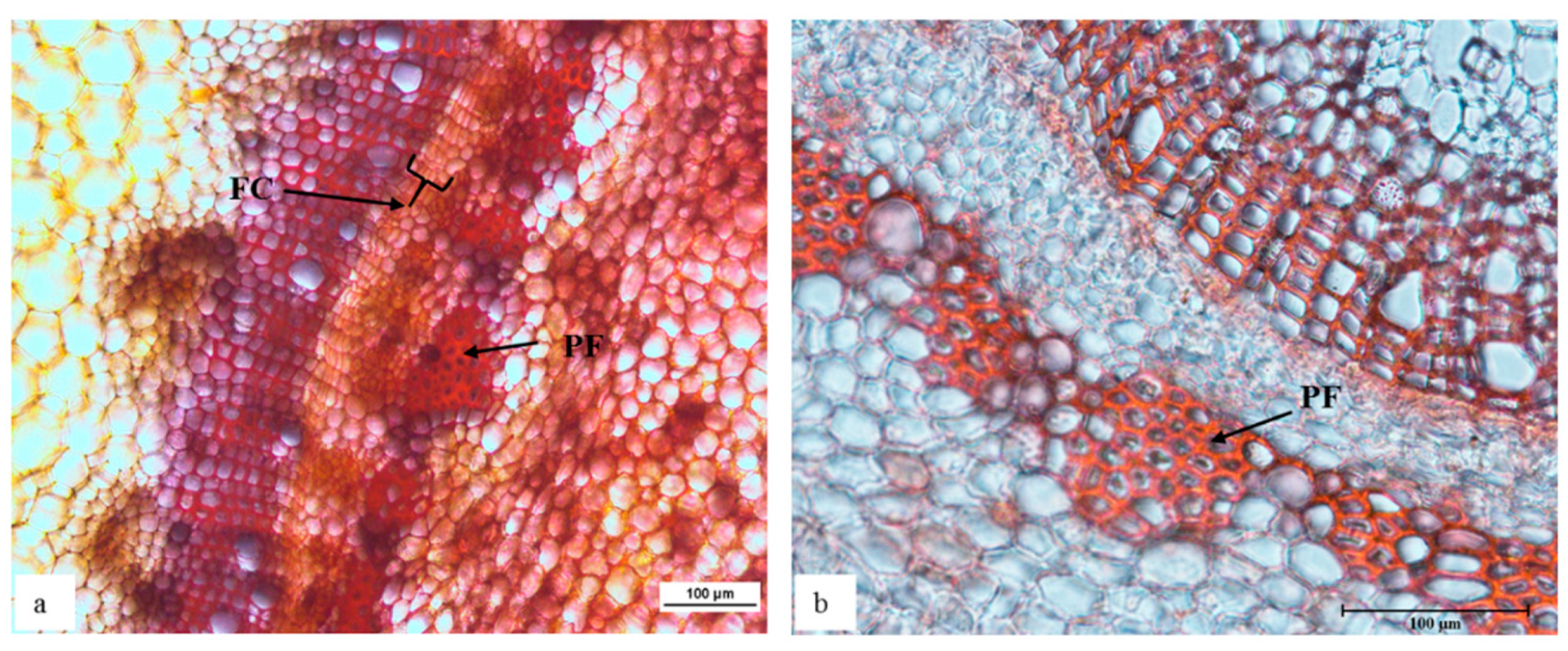
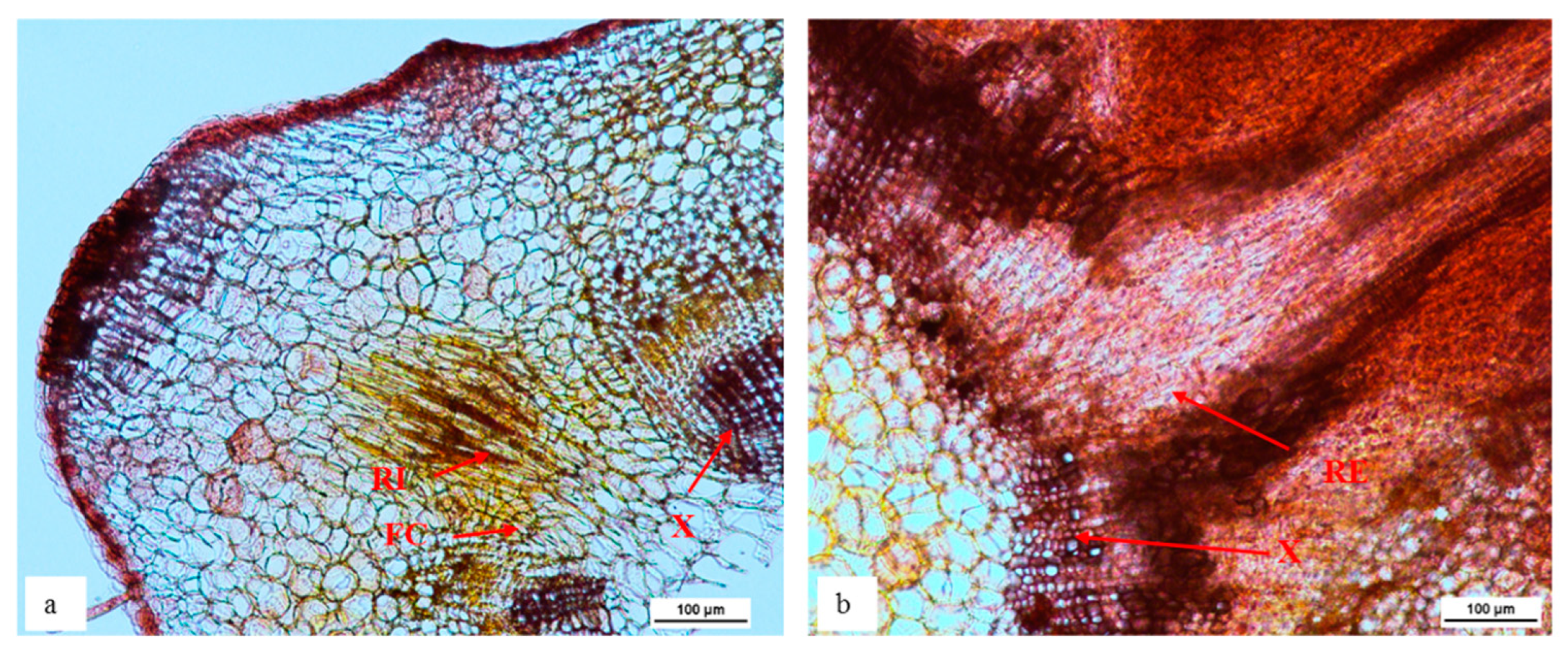
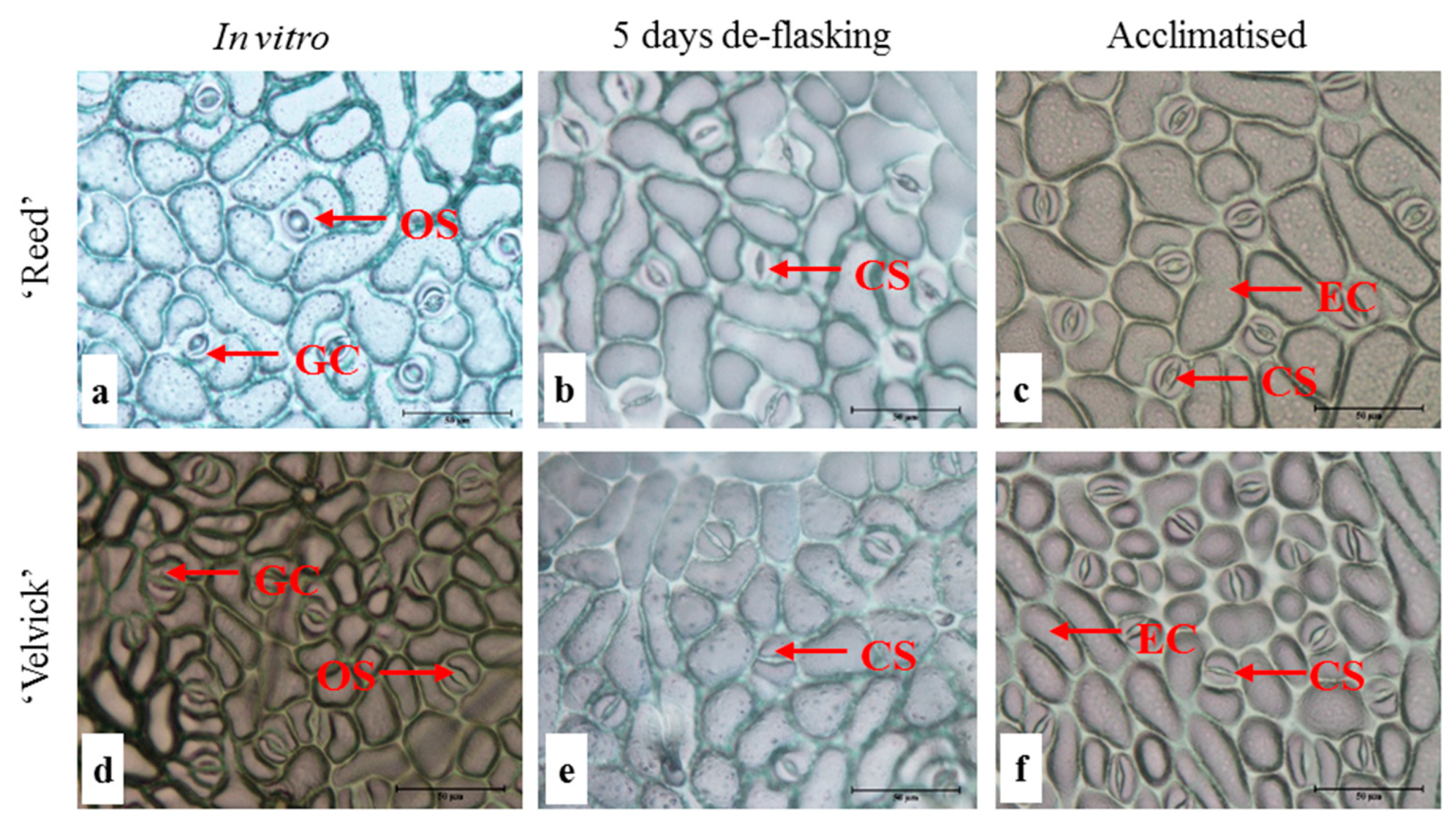

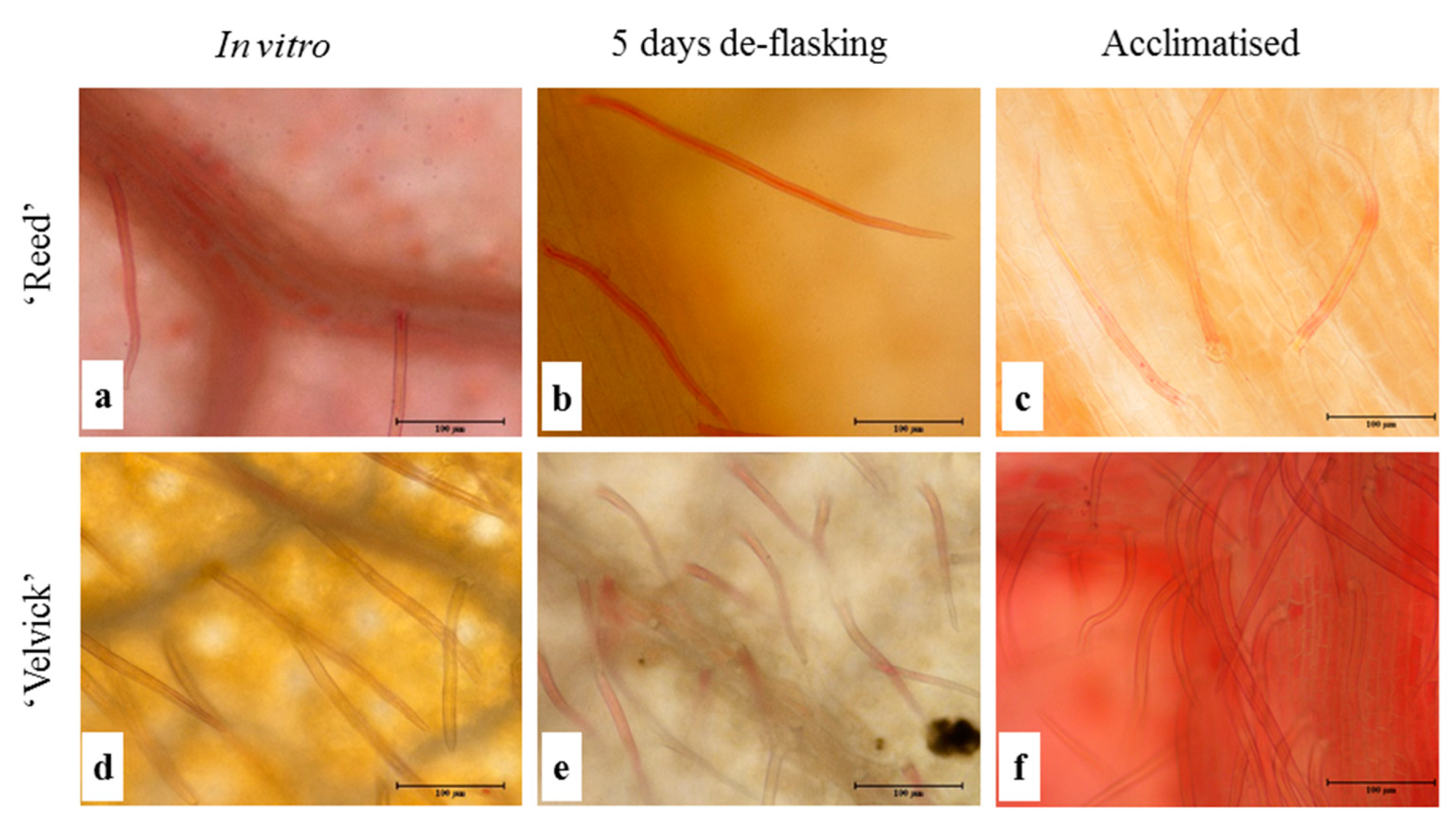

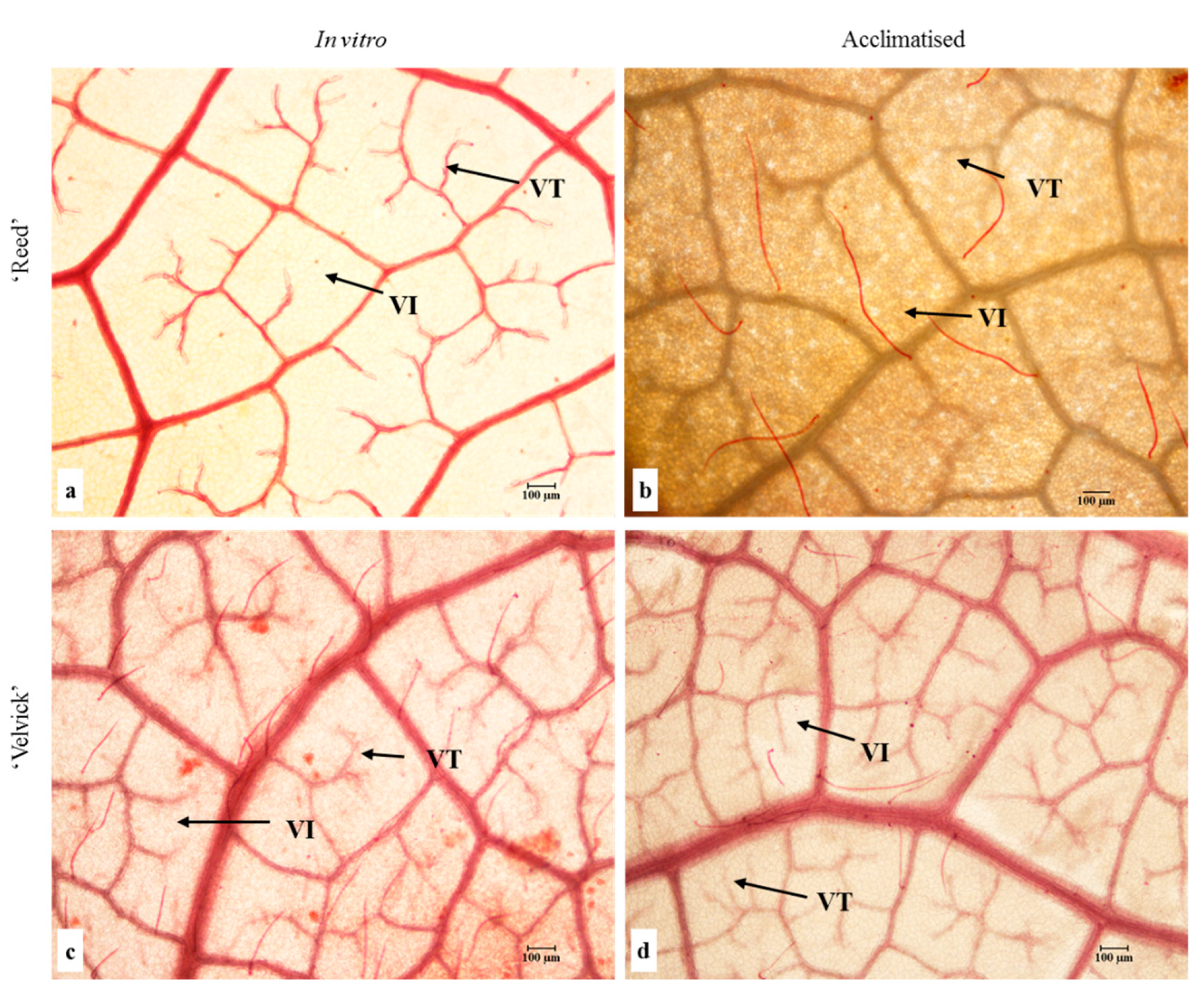
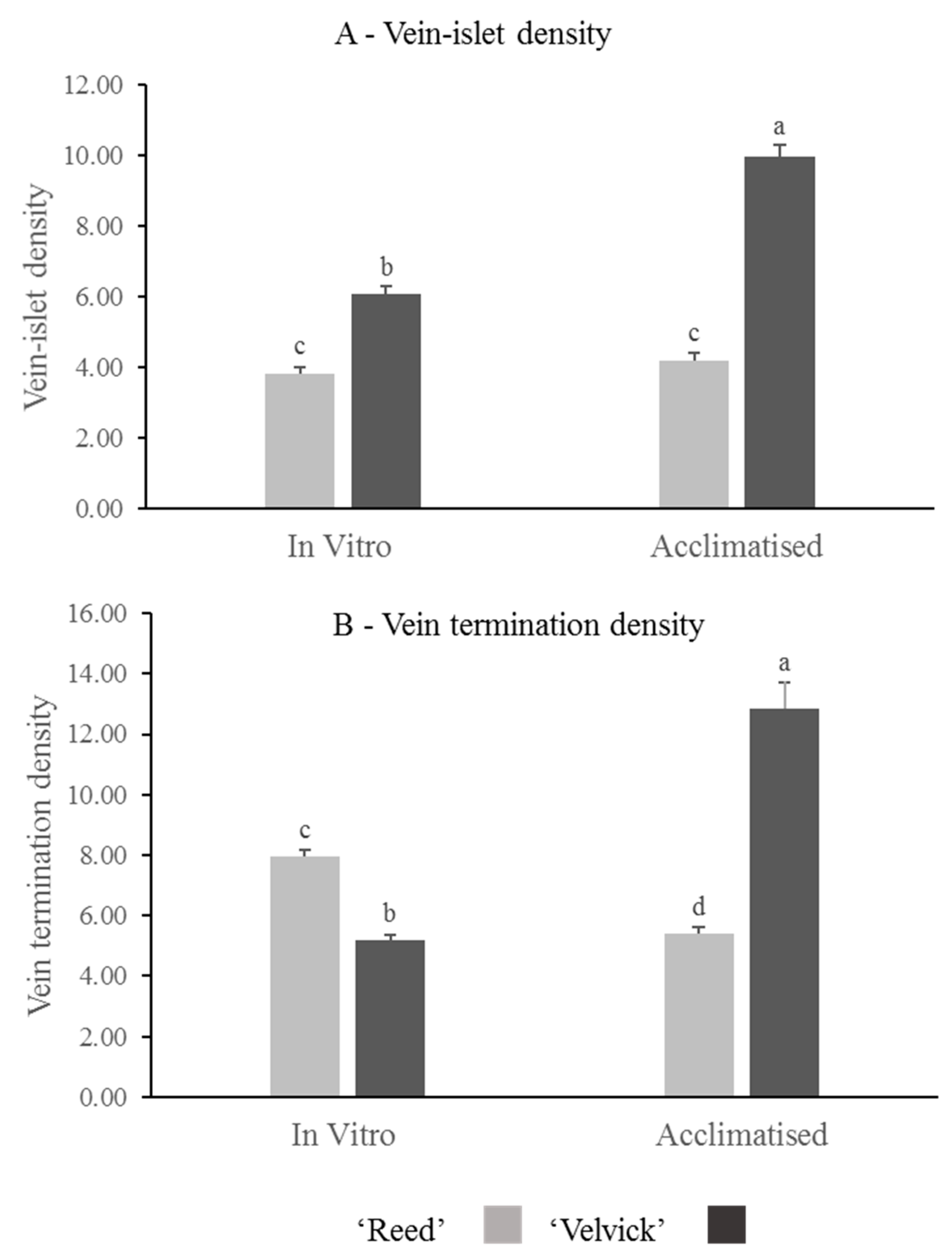

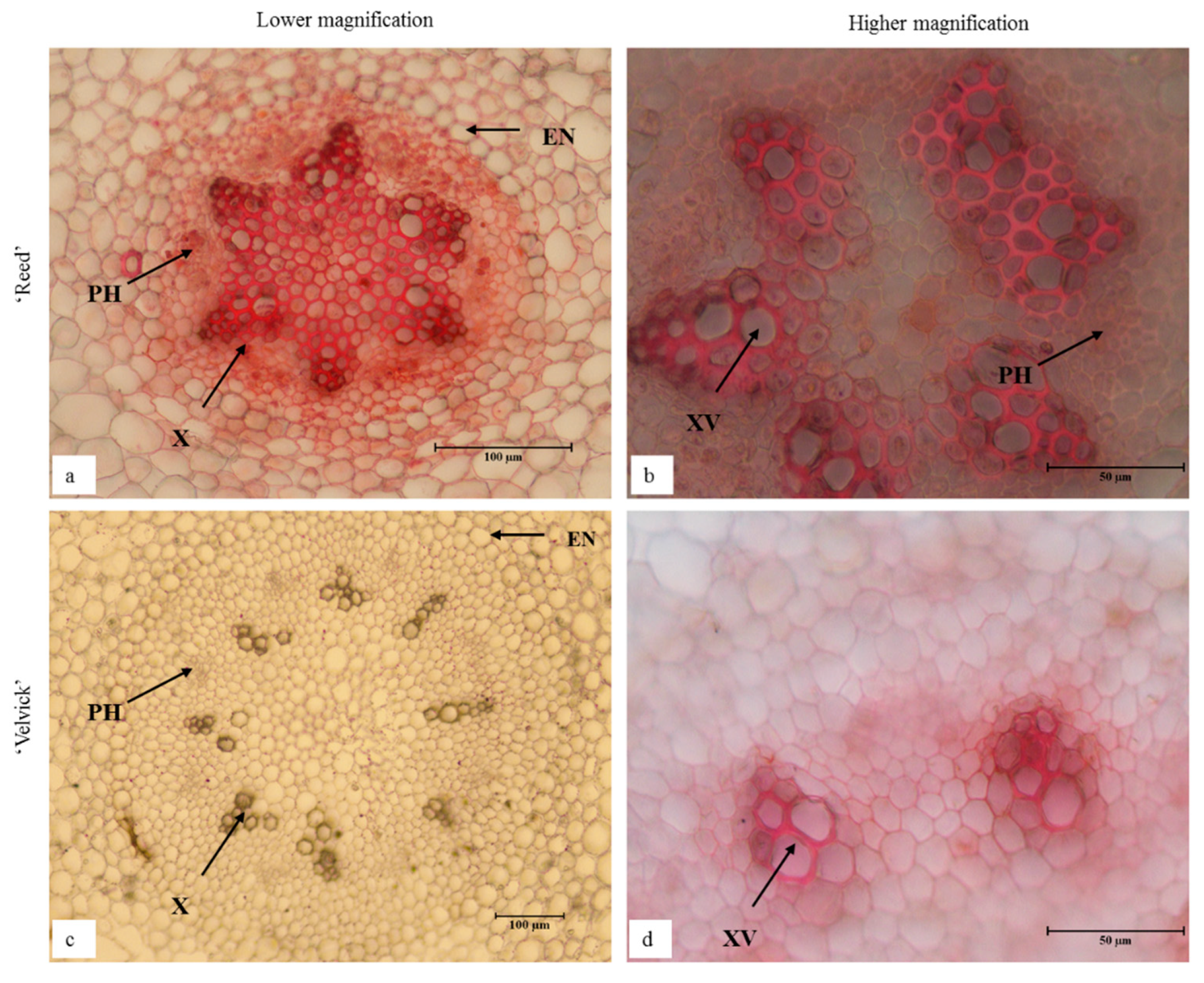
Publisher’s Note: MDPI stays neutral with regard to jurisdictional claims in published maps and institutional affiliations. |
© 2022 by the authors. Licensee MDPI, Basel, Switzerland. This article is an open access article distributed under the terms and conditions of the Creative Commons Attribution (CC BY) license (https://creativecommons.org/licenses/by/4.0/).
Share and Cite
Hiti-Bandaralage, J.; Hayward, A.; Mitter, N. Structural Disparity of Avocado Rootstocks In Vitro for Rooting and Acclimation Success. Int. J. Plant Biol. 2022, 13, 426-442. https://doi.org/10.3390/ijpb13040035
Hiti-Bandaralage J, Hayward A, Mitter N. Structural Disparity of Avocado Rootstocks In Vitro for Rooting and Acclimation Success. International Journal of Plant Biology. 2022; 13(4):426-442. https://doi.org/10.3390/ijpb13040035
Chicago/Turabian StyleHiti-Bandaralage, Jayeni, Alice Hayward, and Neena Mitter. 2022. "Structural Disparity of Avocado Rootstocks In Vitro for Rooting and Acclimation Success" International Journal of Plant Biology 13, no. 4: 426-442. https://doi.org/10.3390/ijpb13040035
APA StyleHiti-Bandaralage, J., Hayward, A., & Mitter, N. (2022). Structural Disparity of Avocado Rootstocks In Vitro for Rooting and Acclimation Success. International Journal of Plant Biology, 13(4), 426-442. https://doi.org/10.3390/ijpb13040035







